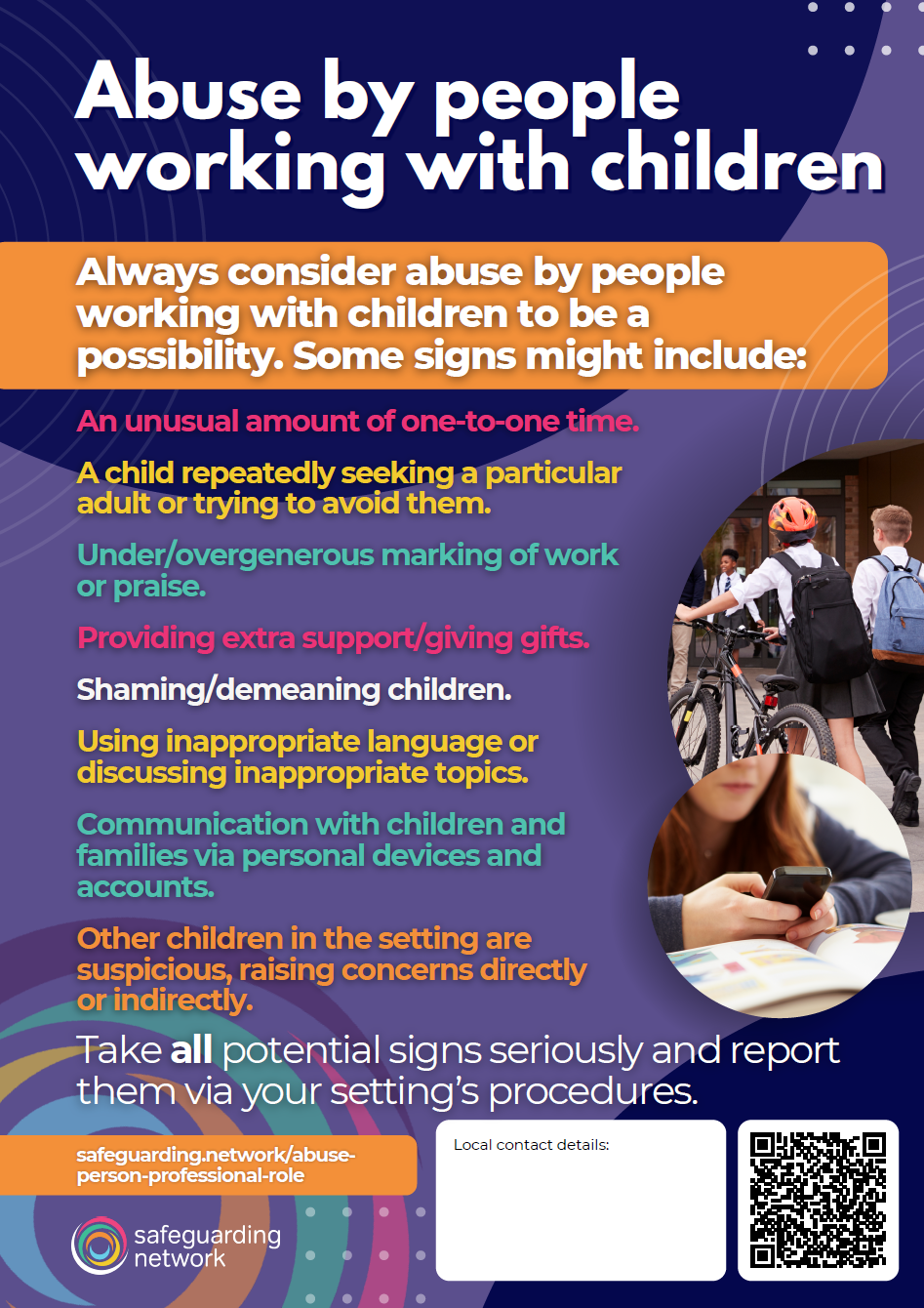Introduction
People work with children across a range of institutions - such as schools, health services, sports clubs, care homes or religious institutions. In this context, sometimes abusers will harm a single child, but those who commit abuse in an institutional context often harm multiple children, and several abusers may be operating within/linked to the same institution. If the institution itself covers up or fails to identify and address abuse by those in or linked to the institution, the negative impact of the abuse is compounded. It’s important to remember that abuse might not necessarily occur within a specific institutional building or work setting. Abusers can use the positive social standing gained from the work to groom and harm others in any context.
Keeping Children Safe in Education says it’s critical that settings create a culture in which all concerns about people working with children are shared responsibly with the right person, recorded and dealt with appropriately.
An open and transparent culture should:
- enable organisations to identify inappropriate, problematic or concerning behaviour early;
- minimise the risk of abuse;
- ensure that people working in, or on behalf of, the organisation understand their professional boundaries, act within those boundaries, and in accordance with the ethos and values of the institution.
Be prepared to think the unthinkable.
Need more?
Thank you for visiting our resources pages. These are free to everyone as is our fortnightly safeguarding bulletin – general safeguarding information is too important to restrict. Become a member to access lots more, including training materials for you to deliver in-house on each topic in Keeping Children Safe in Education.
Sign up for FREE fortnightly bulletin.
What about training?
We can deliver training for your setting on this and other subjects via online platforms, or face-to-face in certain areas. Just get in touch to discuss your requirements.
Definition
"Abuse of someone under 18 years old by a person that works with them. The perpetrator may be a member of staff, a volunteer, work directly with children and young people or work in a support role."
Adapted from the Centre of Expertise on Child Sexual Abuse (2023)
Prevalence
Child abuse is often under-reported, there are many forms of abuse and different contexts in which adults work with children, therefore it would be challenging to know exactly how prevalent abuse by people working with children is. That considered, there is some evidence which might help us understand the extent of this issue.
A study by the University of Greenwich on the retrospective sexual misconduct and harassment of students by teachers in secondary schools in Ireland and the UK found:
- 85% experienced sexual harassment;
- 21% experienced unwanted sexual attention;
- 14% experienced at least one form of online sexual harassment;
- few students reported the incidents to the school, and for those that did, no action was taken.
The Teaching Regulation Agency annual report for year end March 2025 identifies that in the year prior
- 826 investigations began into cases of alleged serious misconduct by teachers
- 297 hearings were held, resulting in 191 teachers being prohibited
Not all serious teacher misconduct relates to abuse of children, but some of the investigations and findings did relate directly to teachers abusing children.
The Independent Inquiry into Child Sexual Abuse published its final Report in October 2022. The Inquiry published 19 reports on 15 investigations covering a wide range of institutions who worked or are still working with children. There was clear evidence of abuse by people working with children and institutions failing to protect children.
The duty of care
When children are in your care you have a duty to keep them safe from harm and abuse.
Every organisation working with children and young people should create a safe environment, supported by a culture of vigilance. This is not just early years, education settings and social care settings, but also community groups, hospitals, sports clubs and religious groups, etc.
Everyone working in regulated activity should be vetted using safer recruitment processes (for education settings see Part 3 in Keeping Children Safe in Education), including checks by the Disclosure and Barring Service (DBS).
No matter how unthinkable, keeping children and young people safe from harm includes protecting them from potential abuse by your colleagues. Everyone undertaking regulated activity should be trained in child protection, be able to spot the signs of harm and abuse and know the appropriate action to take.
The culture of vigilance extends to out-of-school clubs and activities held at any education setting run by an external provider. Governance bodies should ensure that the provider is compliant with the requirements of Keeping children safe in out-of-school settings, and that the leasing / transfer of control agreements reflect this. Allegations relating to any incident that happened when an individual / organisation was using the premises should be dealt with according to your the setting’s normal procedures, including informing the LADO.
Age of consent
It’s a criminal offence to have a sexual relationship with a child under the age of 16. It’s also an offence for an adult to have a sexual relationship with a young person under the age of 18 if the adult is in a ‘position of trust’. This also applies when the young person is under 18 but over the age of consent. (The Sexual Offences (Amendment) Act, 2000)
Levels of concerns and allegations
All concerns against any person working with children should be dealt with following the organisation’s policies and procedures. (Working together to safeguard children.)
The harm threshold for all organisations are concerns/allegations that might indicate a person will pose a risk of harm if they continue to work with children, where it is alleged that someone working with under-18s has:
- behaved in a way that has harmed a child, or may have harmed a child;
- possibly committed a criminal offence against or related to a child;
- behaved towards a child or children in a way that indicates they may pose a risk of harm to children;
- behaved or may have behaved in a way that indicates they may not be suitable to work with children.
For education settings, there is also guidance around concerns/allegations that do not meet the harm threshold – referred to as ‘low-level concerns’. (See Part 4 of Keeping Children Safe in Education.)
A low-level concern is any concern – no matter how small, and even if no more than causing a sense of unease or a ‘nagging doubt’ – that a person working with under-18s may have acted in a way that:
- is inconsistent with the staff code of conduct, including inappropriate conduct outside of work;
- does not meet the harm threshold or is otherwise not serious enough to consider a referral to the LADO.
Examples of such behaviour could include, but are not limited to:
- being over-friendly with children;
- having favourites;
- taking photographs of children on their mobile phone, contrary to a setting’s policy;
- engaging with a child on a one-to-one basis in a secluded area or behind a closed door;
- humiliating children.
Spot the signs
- An unusual amount of one-to-one time in secluded areas.
- Meeting with children behind closed doors.
- A child or young person repeatedly seeking a particular adult or trying hard to avoid them.
- Under/overgenerous marking of work.
- Under/overuse of praise.
- Providing extra support/giving gifts.
- Shaming/demeaning children.
- Using inappropriate language or discussing inappropriate topics.
- Being personally connected with children or young people (or their families) on social media.
- Communication with children and families via personal devices or accounts.
- Other children in the setting are suspicious, raising concerns directly or indirectly.
Grooming behaviours
Grooming doesn’t only focus on children and young people, but also involves the grooming of the victim’s families and the perpetrator’s colleagues to secure access and prevent detection.
In 2024, Neil Foden was found guilty of 19 charges against four female students where he had been Headteacher, including 12 counts of sexual activity with a child and two counts of sexual activity with a child while in a position of trust. The Child Practice Review following his convictions found that there were 50 missed opportunities in relation to identifying and stopping the abuse. At various times, the Board of Governors, Senior Leadership Team, Designated Safeguarding staff and the Local Authority all failed to respond appropriately to the signs and indicators of Foden’s abuse. This was despite concerns being raised by the children themselves, staff members, parents and agencies such as Social Care, health and the NSPCC.
Foden had a long-standing reputation as a bully to both students and staff, he seemingly used fear and his forceful personality to silence people’s concerns and distract them from following even basic good safeguarding practices.
Grooming does not always feature fear, perpetrators may aim to present as caring, hardworking staff and will employ tactics to gain power and one-to-one access to children within or outside the organisation. Whatever the position taken by the perpetrator, the aim and sadly often the result is that people don’t deeply question the harming person’s motives and actions.
Remember, settings such as schools, early years, colleges and care homes provide a regular point of contact with children and young people. Perpetrators can befriend victims with ease. The child’s trust can override the child’s ability to see through deception. The offending by Jeremy Forrest demonstrates this risk. He groomed his student to begin what she believed was a genuine romantic relationship, and easily encouraged her to run away with him abroad even after her parents and professionals were aware of the sexual harm risk. In this case, concerns were also raised about the school’s culture where staff “repeatedly failed to see the evidence of [the teacher’s] misconduct or to hear the concerns raised by students.“
What to do
To reduce the risks, settings should:
- Promote an open culture of vigilance, in which staff may raise concerns without fear of reprisal. Ensure everyone feels comfortable to openly discuss safeguarding issues within (and, where appropriate, outside) the workplace, including online safety.
- Ensure safer recruiting processes and practice are in place.
- Create a child protection policy that includes procedures to be followed if a person working with children is suspected/accused of harming a child and procedures for dealing with low-level concerns.
- Ensure all staff receive appropriate safeguarding and child protection training at induction. The training should be regularly updated and include information on safer working practices.
- Ensure the setting’s attendance processes are robust and that all levels of the system understand how attendance links to safeguarding.
- Ensure relevant senior leaders and governors are trained in managing allegations/concerns about workers, including how to deal with low-level concerns and know how to refer concerns that meet the harm threshold to the LADO.
- Ensure that the children who are the subject of professional concern are spoken to (by the person designated to do this as part of whatever the concerns/allegations process is in action), and their opinions and experiences are taken into consideration and given sufficient weight to impact on outcomes.
- Provide staff, volunteers and children with the necessary tools for reporting concerns. Evidence to all that concerns will be taken seriously and all voices have a right to be heard about any topic.
- Educate children and young people so they can recognise and report issues such as unacceptable adult behaviours, emotional abuse and or inappropriate/illegal relationships and or physical contact.
- Ensure that student and parent/carer have accessible ways to make complaints and that these are investigated robustly and quality assured in line with local and national expectations. The themes and lessons for learning from complaints should be reviewed regularly by the governance to ensure any issues of harm are not going unaddressed.
Reducing the risks
To reduce the risks, individuals should:
- Remain vigilant to the possibility of abuse by people working with children.
- Ensure that you remain up to date in relation to signs and indicators of abuse and ask your DSL if anything at all is unclear.
- Remain aware of how to record and report any concerns about adults who work with children, including those that may meet the harm threshold and low-level concerns. This includes understanding the whistleblowing policy. In general, the following applies:
If you have concerns about a colleague, they should be referred to the headteacher or principal in an education setting or to the manager/owner/designated person in other organisations.
In education settings, if there are concerns about the headteacher or principal, this should be referred to the chair of governors, chair of the management committee, trustees or the proprietor of an independent setting as appropriate.
If allegations of abuse are made against the headteacher or principal, where the headteacher is also the sole proprietor of an independent school, allegations should be reported directly to the LADO. - Understand what you should do if you think you’ve breached your staff/volunteer/contractor code of conduct and seek oversight about any issues in a timely manner.
- Raise any concerns with the designated person, headteacher or principal, manager, etc., as appropriate.
- Follow your managing allegations procedures.
- If necessary, refer directly to the LADO and, if a crime has been allegedly committed, the police.
- Keep taking action until you know children and young people are safe.
Independent Investigations
Independent investigations
Keeping Children Safe in Education says that, “where there is a lack of appropriate resource within the school or college, or the nature or complexity of the allegation requires it, the allegation will require an independent investigator”.
Safeguarding Network can help by sourcing a qualified, insured, DBS checked and experienced investigator. Your setting will receive detailed advice on how to proceed, support at meetings and a detailed report with clear recommendations for your governing body. Contact us for further information.
Building partnerships with parents and carers
When working with parents and carers, practitioners should prioritise a child-centred approach, fostering partnerships to ensure understanding, support and safety.
Remember:
- Collaborative efforts are crucial, especially in cases of suspected harm.
- Practitioners must engage effectively with diverse families, demonstrating empathy, respect and cultural awareness.
- Communication should be clear, inclusive and accessible. Encouraging parental/carer involvement in decision-making and valuing their input is essential.
- Involving families and communities in designing processes fosters a holistic approach to safeguarding children.
- Continuous reflection and adaptation based on feedback from parents and carers enhance practice effectiveness.
Have you considered if:
- the setting’s staff code of conduct and managing allegations and concerns policies are easy to understand and accessible to all parents and carers, with consideration given to things like literacy, language and disability?
- the setting has easy ways for parents/carers to report concerns about abuse people working with children, should they have any?
- all families understand what the boundaries should be between staff/volunteers/contractors and themselves and their children? Would all parents and carers recognise grooming behaviours and how to raise concerns or queries with the setting, should they have any?
FREE Abuse by People Working with Children poster
This downloadable resource raises the profile of safeguarding for your staff team. For use in staff rooms, on safeguarding boards or on the back of toilet doors, the poster includes tips, a space for local contact details, plus a link and QR codes to this resource page. Download the poster from the resources below.
DSL Training Materials
-

Abuse by people Working with Children - Presentation
-

Abuse by People Working with Children - Presenter Notes
-

Abuse by People Working with Children - Handout
-

Abuse by People Working with Children - Quiz
-

Abuse by People Working with Children - Quiz (Answers)
-

Abuse by People Working with Children Scenario - Early Years
-

Abuse by People Working with Children Scenario - Early Years DSL Information
-

Abuse by People Working with Children Scenario - Primary
-

Abuse by People Working with Children Scenario - Primary DSL Information
-

Abuse by People Working with Children Scenario - Secondary
-

Abuse by People Working with Children Scenario - Secondary DSL Information
-

Abuse by People working with Children Scenario - FE
-

Abuse by People Working with Children Scenario - FE DSL Information
-

Abuse by People Working with Children Scenario - SEND
-

Abuse by People Working with Children Scenario - SEND DSL Information
-

Abuse by People Working with Children Scenario - Care
-

Abuse by People Working with Children Scenario - Care DSL Information
Resources
-

Abuse by People Working with Children poster
-

Developing and implementing a low-level concerns policy
-

Better Hiring Toolkit
-

Child sex abuse in institutional contexts
-

Safer working practice for professionals in education settings
-

Safer Working Practices
Save time and improve your safeguarding approach…
Bite-size training materials to share with your staff every month.
Support to explore and develop your safeguarding culture.
A huge array of resources and professional experience at your fingertips.
Get in touch now for a personal tour of the site and details of membership benefits.
We look forward to working with you.


